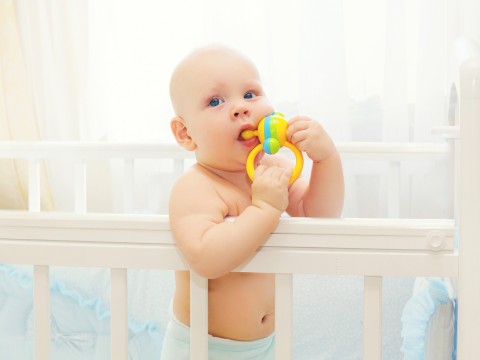

As a new mom in the trenches of motherhood, it can feel kind of like you’re in a weird mommy time warp. I remember the first weeks of motherhood were a never-ending blur of feedings, spit up, pee, poop, tubes of Boudreaux’s Butt Paste®, diaper changes, crying, rocking and repeating.
I felt an enormous sense of accomplishment if I brushed my teeth or took a shower. I was still putting orange juice in the cabinet and juice glasses in the fridge with a baby monitor in-hand at all times, but hey, I was doing it—I was being a mom!
A few months later we were “in the zone” and that’s about the time my son started teething. He wasn’t acting like his usual bubbly self. His appetite decreased, he wasn’t sleeping well and he was really grumpy. I assumed my irritable little guy was coming down with a cold, but he wasn’t. He was teething.
In my mommy mind, I thought it was way too soon for teething, but when I looked inside his mouth I could see the buds. His pearly whites were making their entrance.
Why so chewy and drool-y?
Babies tend to act a lot like puppies during the teething phase–they drool and gnaw on everything in sight. Think of chewing as a satisfying feeling because it helps to numb the teething pain. Pressing down on sore gums counteracts the pain of the teeth pushing up.
The excess chewing stimulates the salivary glands, so that’s why teething babies may drool a lot. The drawback of drooling is that it can cause irritation around the mouth and chin. This is when bibs come in handy, and you may need to change shirts more often to keep him dry.
The diarrhea debate
Some parents see a pattern of symptoms when teething begins that includes diarrhea and diaper rash. As we just mentioned, babies tend to drool a lot during this phase. It could be that your baby is swallowing excess drool during teething that causes mild stomach irritation. This can trigger diarrhea and since diarrhea is moist and acidic, it can irritate baby’s delicate skin.
Diaper rash duty
Whether your baby develops a mild case of diarrhea from swallowing drool or from putting germy objects in her mouth to chew on, keep an eye on her diaper area during teething. The best way to keep diaper rash at bay is to use Boudreaux’s Butt Paste® during every diaper change. Let her skin dry completely after you clean her up and then apply Boudreaux’s® liberally. This protective layer will keep her skin dry and her cheeks happy while she works on cutting her pearly whites.
Pain reliever
Teething can make your baby feel lousy, so products like Little Remedies® Fever & Pain Reliever can help to ease discomfort safely and quickly. The active ingredient is Acetaminophen, which lowers fevers and relieves pain. Little Remedies® products don’t contain artificial flavors or artificial dyes, high fructose corn syrup, aspirin or ibuprofen.
Depending on your baby’s weight, choose the appropriate Little Remedies® Fever & Pain Reliever product. The Little Remedies® Infant Fever & Pain Reliever is for babies 24 pounds or less.
Teethers
Teethers are designed to provide relief for sore gums, so if baby is going to put something in her mouth, it may as well be therapeutic.
There are tons of popular teethers to choose from like BPA-free, natural rubber teethers, teethers with gum massagers and natural wood teethers. You may have to try a few to find one your baby likes. For babies 6 months and older who are having trouble eating, you can find mesh teethers that hold frozen fruit, so she gets digestible nutrition and cool relief at the same time.
Tips about teething
Just like every other stage of baby development, teething doesn’t last forever. Here are some helpful facts to keep in mind, so you know what to expect:
-
The four front teeth–2 on the top, 2 on the bottom–are the central incisors, which tend to cause the most discomfort
-
Incisors are sharp, so they break through the gums easier than molars which start to appear around 18-19 months
-
Your baby may only exhibit teething symptoms 3-5 days before the tooth surfaces
-
Teething can last as long as three years, because it takes time for all 20 baby teeth to come in, but the fussiness usually subsides quickly
-
Babies typically have all of their baby teeth (deciduous teeth) by age 2 ½
What helped you survive your baby’s teething? Share your tips for teething babies with other moms on our Facebook page!


